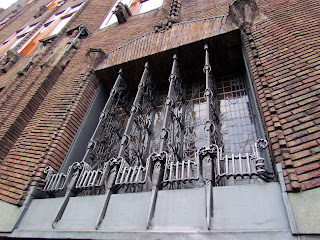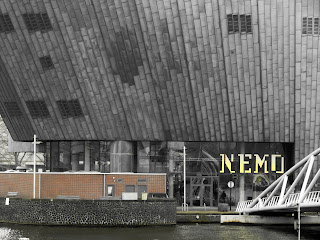Barcelona is a city I have wanted to visit for a while. When
I first arrived in Lille I didn’t think I would make it there. It’s a popular
place to visit and trains fill up fast. In spite of this was able to get
tickets. I left for Barcelona on Thursday morning, prepared for an entire day
on trains. I spent the first leg of the trip traveling to Montpellier, a city
in the south of France. I had a four hour layover and got to explore a little
of the city. It’s a nice city but four hours is all you need to see it. I’ve
been slowly learning to use my new camera (which was given to me by my father
after he deemed it too complicated for him). I took some cool artistic pictures
with different camera settings. After the layover we boarded a train to
Figueres, a city across the border into Spain; then finally to Barcelona. We
arrived after 10 at night, but the weather was good (as it always is in
Barcelona) so we walked to our hostels. I was staying in a different hostel
than my traveling companions. On the way there, we came across Casa Batllo, a
home designed by Catalan architect Antoni Gaudi. It was a magnificent example
of Catalan art nouveau and looked even better when lit up at night. It was a
pleasant first sight for our arrival in Barcelona. After taking a few pictures
and just enjoying the experience, we left to find our hostels. I then checked
in at my hostel and went to bed.
The next day we decided to meet a Sagrada Familia, Gaudi’s
famous Basilica that has been under construction for decades. After leaving the
hostel I made my way over to the massive church. Because I could not see it
from a distance (despite its towering height) I was eager to get my first glimpse
of the grand basilica. I when I first saw it I was awestruck. The towers are so
tall but contain such incredible and delicate detail that it’s impossible to
take it all in at once. The basilica wasn’t even at its final height; the
primary towers have not yet been constructed. After taking a quite a few
pictures I moved to the other side of the church, which was just as
magnificent, if not more so. I met up with my group and we made our way inside
the church. We were disappointed to find fences and gates around the church;
the security was very tight. This fact, however, is put into context with the
knowledge that an arsonist tried to burn down the church a few years back.
There was minimal damage and no one was harmed, but it proves that there are
people who would seek to do harm to this great church.
The interior of the church is beyond my ability to describe.
I cannot do justice to the bizarre interior. The architecture is much more than
fascinating, it’s entrancing. Entering the church is like walking to a place of
myth and legend, a grand and ancient temple. It doesn’t feel like it’s been conceived
by a human mind, but by nature itself. I
could on for pages describing what I saw in just those first few minutes. After
exploring the interior of the church (and taking ridiculous number of pictures)
we head to the elevator which would take us to the top of one of the towers.
The top provided us with a magnificent view of the city. The stairs in the tower were narrow and
steep. Climbing down the tower also gave us an interesting view of the
construction. When we made our way down and reentered the church, we spent
another hour or so trying to understand the space and the experience.
Eventually we had to leave, as there were many other sites in Barcelona to see.
We were slow to leave and I wonder now whether or not I should have stayed
longer.
After Sagrada Familia, we went to another of Gaudi’s
creations, Park Guell. It is an expressive blend between manmade structures and
natural ones. Gaudi took many of his inspirations from nature, so it makes
sense that he would design a park. The park has many different underpasses,
overhangs, and walkways, all made of stone. The stone work held together by
what, I imagine, must be concrete. The stone structures look like they might be
found in the Flintstones. Some of the features of the park work very well with
the nature around them, creating exciting environments to explore and
experience. Some of Gaudi’s features are so interesting though, that they
distract from the rest of the park. Upon entering from the front of the park,
you are greeted by three ornate buildings designed by Gaudi, and a large Iguana
covered in mosaic tiles. Behind the iguana is a large plateau held up by a several
rows of columns. The majority of the people spend their time posing for
pictures with the iguana and sitting on the plateau, pretty much making them
impossible to interact with properly. Crowds aside, the park was very
interesting. We left the park to see one more of Gaudi’s works before the day
was over, so we returned to Casa Batllo.
Casa Batllo is a house remodeled by Gaudi, though it looks
like it was designed by him from the beginning. The building looks very
remarkable — like everything Gaudí designed. The ground floor, in particular, looks
astonishing with tracery, asymmetrical oval windows and gracefully sculpted
stone work. Like many of Gaudi’s works, the building is adorned with mosaic
tiles. The house contains many a subtle homage to St. George, the Patron Saint
of Catalonia, and the legend of him slaying a dragon. I found the house to be
almost as inspiring as Victor Horta’s House (the single greatest example of
architecture I have had the privilege to experience). The complex curves of the
interior walls and ceilings make me wonder why no one ever tried these things
before. It was discovering a whole wealth of techniques that on one has ever
thought to use. The house seemed to be inspired by the realm aquatic. A friend
of mine once described it as “Gaudi’s Atlantis House”.
After visiting Casa Batllo we found a place to eat dinner. I
had Paella. After an extremely long day we parted ways and I returned to my
hostel and went to bed, eager for the next day.





















































